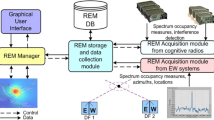Abstract
This paper introduces a rapidly deployable wireless network based on Low Altitude Platforms and portable land units to support disaster-relief activities, and to extend capacity during temporary mass events. The system integrates an amalgam of radio technologies such as LTE, WLAN and TETRA to provide heterogeneous communications in the deployment location. Cognitive radio is used for autonomous network configuration. Sensor networks monitor the environment in real-time during relief activities and provide distributed spectrum sensing capacities. Finally, remote communications are supported via S-band satellite links.
Access this chapter
Tax calculation will be finalised at checkout
Purchases are for personal use only
Preview
Unable to display preview. Download preview PDF.
Similar content being viewed by others
References
Information and Communications in the Aftermath of the Great East Japan Earthquake, Ministry of Internal Affairs and Communications, Tech. Rep. (2011)
Reynaud, L., Rasheed, T.: Deployable Aerial Communication Networks: challenges for futuristic applications. In: 9th ACM International Symposium on Performance Evaluation of Wireless Ad Hoc, Sensor, and Ubiquitous Networks, PE-WASUN (October 2012)
Thornton, J., Grace, D., Spillard, C., Konefal, T., Tozer, T.: Broadband communications from a high-altitude platform: the European HeliNet programme. Electronics & Communication Engineering Journal, 138–144 (June 2001)
The Role of Deployable Aerial Communications Architecture in Emergency Communications and Recommended Next Steps, Federal Communications Comission (FCC), Tech. Rep., Washington (September 2011)
ABSOLUTE (Aerial Base Stations with Opportunistic Links for Unexpected and Temporary Events), http://www.absolute-project.eu/
Reinforcing the Union’s Disaster Response Capacity, COM(2008) 130, European Commission Communication, Tech. Rep. (March 2008)
Reynaud, L., Rasheed, T., Sithamparanathan, K.: An integrated Aerial Telecommunications Network that supports emergency traffic. In: 14th Symposium on Wireless Personal Multimedia Communications, WPMC (October 2011)
Talbot, D.: 80 Seconds of Warning for Tokyo. MIT Technology Review (March 2011), http://www.technologyreview.com/news/423274/80-seconds-of-warning-for-tokyo/
Public Safety LTE, http://enterprise.alcatel-lucent.com
Hunter, J.: Telecommunications delivery in the Sydney 2000 Olympic Games. IEEE Communications Magazine (2001)
Goddemeier, N., Rohde, S., Pojda, D., Wietfeld, C.: Evaluation of Potential Fields Strategies for Aerial Network Provisioning. In: 2nd Workshop on Wireless Networking for Unmanned Autonomous Vehicles, Wi-UAV (December 2011)
Allsopp Helikites Limited, http://www.helikites.com
Holma, H., Toskala, A. (eds.): LTE for UMTS - OFDMA and SC-FDMA Based Radio Access. Wiley (2009)
VESNA (2011), http://sensorlab.ijs.si/hardware.html
Mitola, J., Maguire, G.Q.: Cognitive Radio: Making Software Radios More Personal. IEEE Personal Communications 6(4), 13–18 (1999)
Haykin, S.: Cognitive Radio: Brain-Empowered Wireless Communication. IEEE Journal on Seleted Areas of Communications 23(2), 201–220 (2005)
Mariani, A., Kandeepan, S., Giorgetti, A., Chiani, M.: Cooperative Weighted Centroid Localization for Cognitive Radio Networks. In: IEEE International Symposium on Communications and Information Technologies (ISCIT) (October 2012)
Kandeepan, S., Giorgetti, A.: Cognitive Radio Technqiues: Spectrum Sensing, Interefrence Mitigation and Localization. Artech House (October 2012)
Author information
Authors and Affiliations
Editor information
Editors and Affiliations
Rights and permissions
Copyright information
© 2013 ICST Institute for Computer Science, Social Informatics and Telecommunications Engineering
About this paper
Cite this paper
Valcarce, A. et al. (2013). Airborne Base Stations for Emergency and Temporary Events. In: Dhaou, R., Beylot, AL., Montpetit, MJ., Lucani, D., Mucchi, L. (eds) Personal Satellite Services. PSATS 2013. Lecture Notes of the Institute for Computer Sciences, Social Informatics and Telecommunications Engineering, vol 123. Springer, Cham. https://doi.org/10.1007/978-3-319-02762-3_2
Download citation
DOI: https://doi.org/10.1007/978-3-319-02762-3_2
Publisher Name: Springer, Cham
Print ISBN: 978-3-319-02761-6
Online ISBN: 978-3-319-02762-3
eBook Packages: Computer ScienceComputer Science (R0)




